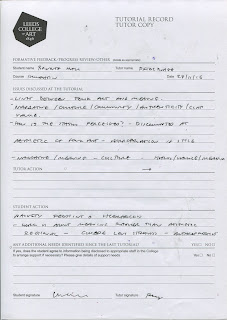Jay showed me the work of Jonny Hannah, a print-based illustrator whose images definitely possess a folky quality. He also distributes prints and publications under the name of Cake & Ale Press. This will link my research to contemporary illustration also.
He has also been known to paint and adorn atypical surfaces and materials such as suitcases, guitars, toys, coffee pots, which aligns with the resourceful nature of folk art - using what's around you to create something.
I got Jonny's book 'Greetings from Darktown: An Illustrator's Miscellany' from the library. Although the book doesn't claim a direct link to folk art, it is clear from the blurb that he is influenced by the vernacular arts:
'...A mysterious coastal town of arcane establishments inhabited by folk legends, jazz artistes, tattooed sailors and the action hero Rocket Man. Accompanying Jonny are the writers Philip Hoare and Peter Chrisp, who explore the eclectic influences on Hannah's work'
The motifs within his illustrations are reminiscent of past eras, seaside towns, tattoo parlours. Handrawn typography is also a huge part of his work, which reminds me of hand-painted shop fronts and signage from old-timey funfairs and amusements.
illustrations from 'Greetings from Darktown'
pg 13. Animating the Impossible: The Art of Jonny Hannah by Philip Hoare
'Hannah's art is applied in the best sense. It bursts out of his brain and on to the page, on to wood, through a silk or even a computer screen.'
'It is provincial, anachronistic, transatlantic, European, futuristic, international'
'Prolific, self-propagating, it is full of pattern and surface, sliding over entire time zones: from nineteenth-century sailors and whalers, through 1920s movies and French nouvelle vague, from smoky jazz dives in Harlem to salty promenades of semi-forgotten resorts and haunted ports.'
'Hannah's is a new vernacular, a folk art for the twenty-first century, entirely closed-in...yet far-ranging and unlimited by mere practicalities, for all that it is sourced in the apparently commonplace'
pg 14. '...somewhere you might reach through the lanes of a Paul Nash or an Eric Ravilious landscape, via Peter Blake, along Route 66, in the company of Charlie Parker and Hank Williams.'
'Every image that Hannah creates has its own narrative; each picture and illustration and assemblage is its own short story. If he weren't an artist, Hannah would be a writer or a British version of the French flâneur, a dandy figure wandering the streets in search of new sensation.'
pg 15. '...his characteristic typefaces are woven through his pieces as a continuing theme: a Victorian or Edwardian sampler, a Powell and Pressburger film, a sideshow at the Festival of Britain, a speakeasy in New York.'
'Hannah's world revolves around his fertile, magpie imagination, picking up that which history and our contemporary culture have left behind'
—
I really like how this practitioners work is an assemblage of his interests and influences, but there are also hidden narratives and personal aspects which give something authentic and unique to the pieces - going beyond just copying or emulating a style.
I think this is what's important when I come to doing my own practical/visual work, to make historical and other references and connections, whilst imposing my own story, narrative and meaning on to them.

































